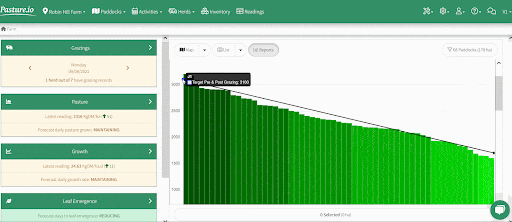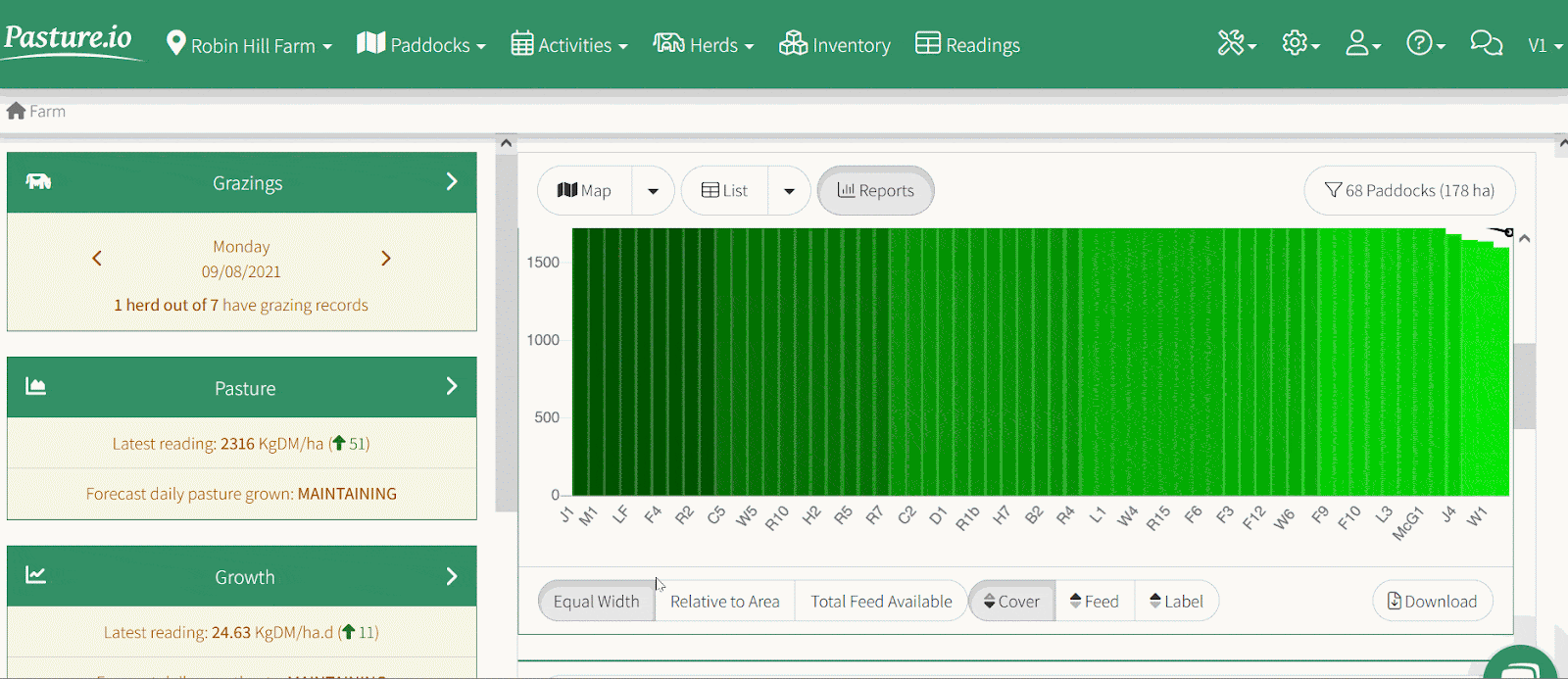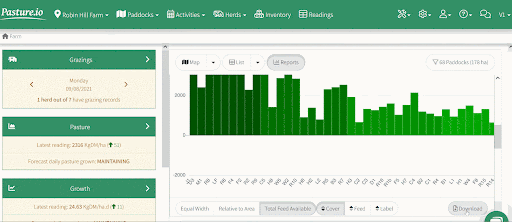Article Summary:
The grass feed wedge is a farm management tool that provides a visual picture of the amount of feed available over time. Feed wedge is acquired by smart dairy farmers like yourself to manage the grazing effectively, meet growth targets, and manage surplus profitably. With Pasture.io’s predictive feed wedge, dairy farmers can easily predict the grass yield for the upcoming season and make proactive decisions profitably.
Introduction to the Feed Wedge
A feed wedge, also known as a pasture wedge or grass wedge, enables farmers to visually see how the pre-grazing yield is distributed across the paddocks for making best grazing decisions.
A feed wedge has many feathers in its cap and helps farm management maintain pasture smartly and profitably. We recommend using Pasture.io to easily acquire a feed wedge and make predictions into the future, take decisions based on these predictions and get rid of inaccurate and tiresome traditional methods like rising plate meter.
Plus point: Pasture.io gives a colourful graph making it visually appealing to easily identify pasture cover, surplus, or deficit.
Today, we will discuss the need of acquiring a feed wedge on your progressive farm and look inside to see what a feed wedge reveals about your pasture growth. Furthermore, we will discuss the practical utilization of information revealed by a feed wedge. Without further ado! Let’s see 7 reasons why we use a predictive feed wedge.

7 Reasons why we use a predictive feed wedge
There is a great incentive in using feed wedges to overcome the grazing challenges and achieve higher pasture utilization. Therefore, Pasture.io has made it easier, accurate, and stress-free.
Seven ways a feed wedge can help you are:
- Accurately measure the average pasture cover.
- Identify pre-grazing target.
- Identify post-grazing residual target.
- Identify surplus/deficit early.
- Make proactive grazing decisions every day.
- Make stress-free management decisions.
- Make timely decisions profitably.
Bonus Point: Remember, a feed wedge is most useful when rotation length is not changing. In seasons when rotation length is changing, feed wedge is best utilized with other pasture management tools.

Understanding the Pasture Feed Wedge
Like I stated before, a feed wedge is a visual representation of pasture yield over time. There is a target cover line that helps farmers stay on track with their grazing game. There are two y-axes on the Feed wedge drawn by pasture.io, one represents growth rates in KgDM/ha per day while the other represents pasture cover in KgDM/ha. The X-axis shows individual paddocks.
The predictive nature of Pasture.io’s feed wedge makes it possible to look into any day in the coming weeks and alter grazing decisions to align with growth rates.

Practical utilization of Feed Wedge
A feed wedge has the answer to three questions every farm across the globe is concerned with.
Farm management ought to figure out how many paddocks it can take out of rotation and when is the best time to do so. Also, the best and most logical options available to farm’s grazing management keeping in mind the pasture covers and pasture growth targets. Finally, if the paddock is in surplus, knowing it at the earliest time would allow the farm management to make the best decisions.
How many paddocks do we need to take out?
By using feed wedge, farmers can find the answer to how many paddocks do they need to take out.
This will depend on three things.
- If the farm has a pre-grazing cover target higher than the farm needs. This indicated a surplus that can be shifted to days when there is less pasture cover available for grazing.
- The farm is meeting the desired post-grazing residual targets.
- The farm deems it fit to take out paddocks for surplus.

What is the most logical grazing strategy available?
A feed wedge lets farmers see their most logical next option and make the most out of the pasture cover.
- See the paddocks falling in upcoming days that are above the pre-grazing cover target line, followed by a group of paddocks that are below the target line.
- Take the surplus paddocks to restore the grazing residual targets.
- You have the option to slow down the rotation, meet the post-grazing targets. This way, farmers can give more time to paddocks below the growth line to reach the pre-grazing height.
Is your paddock in surplus?
If your farm is in surplus, a feed wedge makes it easier to let you decide whether you need to book a silage contractor or not.
- Note the paddocks that are at the pre-grazing target.
- The farm is efficiently meeting its post-grazing target.
- Note the paddocks that are way above the target line and make preparations accordingly.
It’s great to see farmers benefiting from the smart utilization of farm management tools and profitably meeting farm growth targets. A feed wedge is an answer to effective management of pre-grazing and post-grazing residual targets.
Pasture.io makes it hassle-free, easy and accurate to refine your grazing management. This brings us to the end of the article.
Until we meet again, Happy Grazing!
- The Dedicated Team of Pasture.io, 2022-03-17